2D + 2D = 3D pt.5
 Tuesday, March 3, 2009 at 9:03AM
Tuesday, March 3, 2009 at 9:03AM Part 1. Part 2. Part 3. Part 4.
Navigating, interacting, and interpreting 3D space is too difficult for the average gamer. When Mario 64 came out, we all had to learn that perspective is a key factor with 3D games. To play this 3D platformer well, players had to master Mario's moves as well as the camera control. Not only does the camera provide the game view, but the camera position also affects the player's controls. To experience this effect first hand, try moving Mario in a straight line toward any target while constantly spinning the camera around. If you do this, you'll quickly understand that to keep Mario moving straight, you have to compensate by rotating the analog stick in the opposite direction of the camera rotation and at the same rate.
Mario's movement controls have always been relative to how we view the game world. In Super Mario Brothers, a 2D side-scrolling platformer, holding right always moved Mario to the right and toward the end of the level. In a 3D game, how we view the gameworld changes relativity of the controls. Understanding the relationship between the camera perspective and the controls requires constantly triangulating the positions between the Mario (the player avatar), the target, and the camera position. Such calculations are more than most people are willing to actively do. Fortunately, most gamers have naturally developed a few tricks that simplify the 3D space and 3D triangulations.
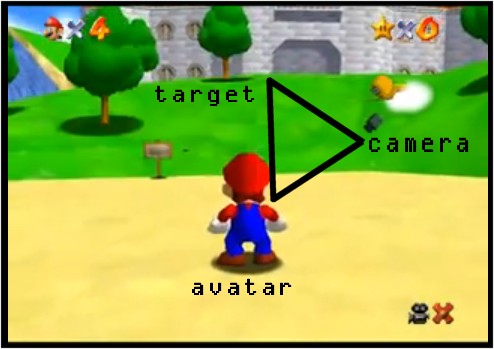
I've watched many people play Super Mario 64. When up against tricky platforming challenges, the gamers that weren't comfortable triangulating the game space used an interesting technique. By moving the camera so that the perspective lines up directly behind Mario, players essentially change the 3D perspective challenge, into a 2D challenge. Now the player only has to focus on moving forward and JUMPing at the right time. In other words, the 3 points/factors that make up the triangulation can be manipulated into 2D line, which is a much simpler geometric shape.
Simplifying 3D doesn't just happen in 3D platformers. All 3D games with a player controlled camera system have the potential to simplify or clutter the fidelity of the game perspective. To help us out, developers have designed mechanics that help to simplify 3D gameplay.
Simplifying 3D
Super Mario 64 showed the world how 3D spaces, mechanics, and cameras can be designed to take advantage of they dynamics of 3D space. Unlike the 2D Mario platformers that came before it, the enemy design and influence in Mario 64 is very minimal. With such a volume of space to platform in, enemies are much more infrequent, must less effective, and no longer a critical element in what makes the game's challenges challenging. Now that players have 8 health points, Mario can take several hits before dying. And if a player is ever low on health, a few coins or some water can restore Mario's health. Mario 64 isn't designed around combat.
It wasn't until The Legend of Zelda: Ocarina of Time (OOT) that 3D combat was revolutionzied. Just like with their 2D games, the difference between Mario and Zelda's enemies are great. In OOT, enemies are designed with greater degree of complexity. They will seek you out using pathfinding, strafe around you, go on the attack, switch to defense, run away from you, wait for you to get close, shoot you at range, etc. Zelda enemies can exist at any point in 3D space around Link. Enemies in Zelda can swim in the water at your feet, fight you on the ground, hover just above the ground, or fly around high into the air. When fighting these enemies OOT gives players a range of perspective changing design techniques/mechanics that increasingly simplify the 3D gameplay into 2D gameplay. The first design feature I want to cover is functionally equivalent to when players line up the camera in Super Mario 64 to make difficult jumps.
Lock-on Mechanics & Relative Space
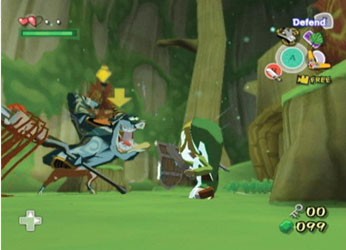 I know the discussion is on OOT, but this image is just too awesome.
I know the discussion is on OOT, but this image is just too awesome.
By holding the Z button on the N64 controller, players are able to lock the camera view behind Link and a pointed squarely on a target. If Link moves when locked on, the camera stays behind him. If the target moves, the camera swivels to stay focused on it. When locked-on, forward and back movement is relative to the target. At the same time, side to side movement is also relative causing Link to circle strafe around the target.
Along with the focused perspective and altered movement capabilities, the lock-on mechanic also uses pathfinding or auto-aim to point all of the player's attacks at the target. Whether the player uses sword strikes or projectiles, they are always automatically aimed at the target. This is significant because of how a 2D plane of relative space is created between the player and the target. With either grounded or flying enemies, when the aim is auto adjusted in this way, the necessity to triangulate between the avatar, target, and camera is eliminated. Locking on creates a functional line of intent between the player and the target. With only 2 points/factors to consider (avatar vs. target) the 3D space the factors take up is simplified to a 2D relationship.
Other games that use lock-on mechanics are DMC4, Ninja Gaiden Sigma, and all of the 3D Zelda games. Games like Katamari Damacy and Super Monkey Ball feature a camera system that is locked behind the player avatar's back. This design helps simplify the perspective of the game and the camera control. Taking the concept of combined player and camera controls, there is a type of 3D perspective that offers freedom of movement, freedom of aim, and a fixed perspective. For these reasons this perspective greatly simplifies 3D gameplay, which is probably the reason why it is so popular today.
The First Person Perspective
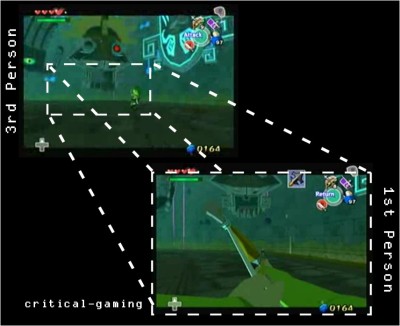 You can watch the boss fight here.
You can watch the boss fight here.
The first person perspective shows a game world through the eyes of the player avatar. In games that give the player camera/view control, the player is put in control of viewing the game world. Compared to the 2D perspectives and 3rd person perspectives, the FP perspective is the most limiting game view (see image above). Players are limited to a narrow cone of vision that displays much less than what is contained inside the average human vision range. For these reasons, the player must actively look around to understand the world around him/her. In this way, understanding the 3D world is a core dynamic.
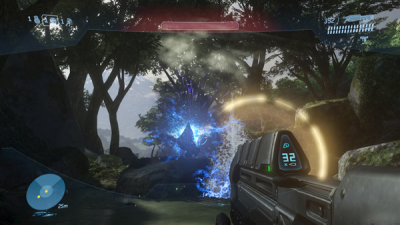
With first person shooters, looking and aiming are one. When holding a gun, everything you see is set along the sights of the firearm. With dual analog, keyboard and mouse, or Wiimote + Nunchuck controls, aiming/looking is essentially 2D. Because guns are such accurate and powerful weapons, when firing bullet like projectiles the 3D space between the gun barrel and the target is compressed and almost entirely minimized. In other words, when you pull the trigger, if the target is in your sights it's a hit. If the target is not, it's a miss. In this way, FPS aiming and shooting is functionally 2D.
Many people think that FPSs are fairly simple. The left stick controls the character movement like a top down game. The right stick controls the aim and perspective in 2D. To hit targets, one needs to only align the reticle and push a button. Combining these two systems allows for players to move through 3D space, but at the same time simplify 3D space by compressing it into functionally 2D space.
From Super Mario Galaxy to Halo 3, understanding 3D gameplay games consist of understanding the mechanics, perspective, and how the 2D inputs from the game controllers translate into the 3D space. Now, with the Wiimote, the Sixaxis, and even the Novint Falcon games can finally let players control 3D mechanics using 3D inputs.
3D Mechanics/Input/Interaction
The Wiimote is to 3D control, as the touch screen is writing/drawing controls. Sure, with a lot of practice you can become quite a competent artist using a D-pad. But writing or drawing in this way isn't isn't as intuitive or as versatile as using a touch screen. In the same way, nothing can be more intuitive for a 3D mechanic/interaction than a 3D input.
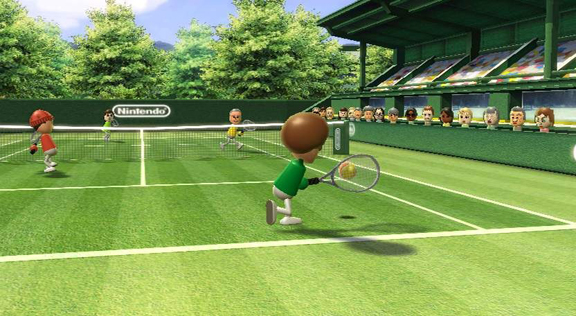
Take Wii Sports Tennis for example. With one motion of the Wiimote, I can put a variable amount of spin on the ball, hit it toward a specific side of the court, launch it a specific distance upward, and drive it with a specific amount of force forward. In other words, I can control the power, direction, and spin of the ball all in one intuitive motion. If Wii Sports Tennis were designed around a more traditional controller, there would probably be separate buttons for the lob, slice, and top spin shots in addition to the ability to hold down each button for increased power. The Wiimote Wii Sports Tennis design simplifies the controls by removing buttons and making the motions intuitive while keeping the directness of the mechanics very high. All of the Wii Sports games are designed with this level of 3D intuitive and direct mechanics.

Excite Truck: In this game players can land their trucks from the air on all four tires for a speed boost. Because the terrain is so uneven, bumpy, and hilly, landing on all tires requires the player to angle the truck beforehand in mid air. Controlling the truck is as simple as tilting the Wiimote as if it were the handle bars of your truck. Turning and tiling the truck in mid air engages all 3 dimensions, making the air control mechanic a 3D controlled mechanic in a full 3D gameplay game.
These 3D motion controls also create a new kind of perspective that's based on how you play the game as opposed to how the camera displays the game world. The direction Mario moves when pushing the analog stick in one direction is dependant on the camera position. But no matter how the camera is positioned in Wii Sports Tennis, swinging the Wiimote the same way will always produce the same effect because of how the motion controls are intuitively designed to mimic real life tennis swings.
We have come to the end of a long and detailed look at 2D and 3D dynamics and game design. Hopefully, now you understand that 3D space is little more than an added dimension that changes everything in the world of game design. So many have made 3D games, and so many have missed the mark in one way or another. It's not surprising that the Mario and Zelda games provided such excellent examples for side-scrolling, top down, and 3D game design. After experiencing Super Mario Galaxy and The Legend of Zelda: Twilight Princess, two games in two long running series of 3D space and game design innovators, I know that video games are capable of even greater levels of design.
Perhaps the next step for 3D gaming is head tracking.
 Halo,
Halo,  Wii Sports,
Wii Sports,  Zelda in
Zelda in  Abstraction,
Abstraction,  Controller Design,
Controller Design,  Dynamics |
Dynamics |  Permalink |
Permalink |  Print Article
Print Article 

Reader Comments (10)
I've been wanting to send you this all throughout this series. Someone is trying to create a 4D space representation (+ time as well). It seems like trying to work with it will eventually destroy someone's sanity, but the effort is interesting.
I think you know all of the following, but I still want to point it out:
Jumping in most 3D games gives you the ability to control your movement in both horizontal directions, while gravity and time affect the vertical dimension. While I don't see many challenges requiring this, most people seem annoyed when its not there.
Boom Blox presents both 3D control and 3D challenges, along with simplification that doesn't significantly reduce the amount of control.
The following are less about 3D control and more about challenges in 3D games:
Pikmin, Mario 64, Total Annihilation, and many other games use 3D terrain to adjust speed of movement and range of projectiles. This makes pathfinding more complex.
3D movement in Mario Kart Wii makes a big difference in jumping and traction. Minor differences in direction at the start of the jump change the landing drastically. The 3D composition of the landing area makes a big difference as well.
@ Bryan
Do you have a link to the 4D work?
I take it the horizontal control you're talking about with jumps is the unrealistic (yet comforting) ability of "air control." You're right. There are few games and few cases where air control must be done to progress that I can think of. I know that there are some falling part in Mega Man 9 that the player must air control to avoid falling on spikes.
Super Ghosts and Goblins, Bionic Commando, and I believe Mirror's Edge are examples of games without air control. It's very jarring not to have it at first, but most of us just adapt.
I thought about Boom Blox for a while and I came to the conclusion that it doesn't have 3D controls for the primary mechanic THROW. The game actually uses two 2D systems and one 1D system for its primary mechanic. You rotate the camera (2D). You point the reticule (2D). And then you release the ball which I believe flies at a force that's quantified from the analogy wiimote data into one of 3 speeds. This system is very similar to how you select your pitch style via buttons and then use motion control to determine the speed of the pitch in Wii Sports Baseball. Having said that, I do think that the PULL and SWING mechanics in Boom Blox are 3D controls.
Halo 3 and COD4 are two good examples of FPSs that use a lot of 3D terrain and geometry to sculpt the multiplayer combat.
Good comments.
Here is the 4D maze game. I thought I had included it in the original post. Oops!
http://www.urticator.net/maze/
For Boom Blox, I considered that the control was taking placing during a single turn, and that you had full control to mix the two dimensions. Actually shooting the ball has the same effect as if you had full control. Really, you get as much control as lock-on in a Zelda game, trading vertical movement for depth.
More importantly, the challenge is fully 3 dimensional, without restrictions like terrain height or jump direction to limit it. The blocks move in all directions and height changes throughout the game as pieces fall.
@ Bryan
Indeed. Boom Blox is a 3D game that uses somewhat realistic physics interactions to create challenges. This puts the game into the full 3D gameplay category. This is the most significant and important point because it describes the core gameplay of Boom Blox.
I wanted to point out something critical in your last comment. You said that you took the mechanics/inputs of Boom Blox to be 3D because you combined all the actions the player does in a single turn as 1 effort. If you look at it this way, then yes the mechanics/input would be 3D. But the game being turn based doesn't let us consider all of these separate input systems as 1. Your comment highlights the fact that it is very possible to create 3D interactions by combining several 2D ones.
Perhaps the distinction between 2D systems that stack into 3D and 3D systems that can be broken down into 2D systems is quite thin.
Thanks for the link. Good follow up comment.
Homeworld (3D space RTS) used a similar system of combining multiple 2D inputs to allow 3D movement.
A single movement involved inputting a change in distance in the same plane and a change in plane. The game would then compute a smooth path to the destination and perform the move.
At any time, you could also change formation, give orders to attack, and other standard RTS commands.
From a completely different angle, how do you see an Etch a Sketch? You adjust two 1 dimensional controls to create a 2 dimensional picture. Adjusting the knobs at the same time is very difficult, though, so you can't really create curves.
Then you have most grid turn based games, where your character can only move in 1 dimension, but multiple characters can move in different directions from each other. How do you see Chess?
@ Bryan
I'll have to check out some videos on Homeworld.
I actually mentioned Etch a Sketch in this article before I edited it out. I tried to create a parallel between 3D motion controls vs traditional controls for controlling 3D games, and how the D-pad is superior to the Etch a Sketch knobs. True, the knobs are 2 1D inputs. And learning how to draw with them has a learning curve because they're not intuitive. The reason my analogy fell apart is because the Etch A Sketch can do curved lines better than a D-pad, even though controlling these curves is very difficult.
If it's a grid based game like Advance Wars or Fire Emblem, then you can move in 2D. Like Chess, these games are 2D with quantified movement.
Chess pieces can only move in a single direction per turn and can't move around obstacles. Multiple 1 dimensional movements over multiple turns allow a 2D challenge with 1 Dimensional control.
(Knights are a little harder to quantify, but have at most 8 spaces they can move to.)
Also, what about Super Smash Bros 3D Hitboxes? Wasn't this a 2 Dimensional game? Doesn't this make it 2.5D?
http://critical-gaming.blogspot.com/2008/08/next-gen-fighters-and-flow-of-combat.html
My real point here is that I think we need to focus on how 1D vs. 2D vs. 3D mechanics are actually used. At the game level, they are too confusing. You do this already for most of the articles.
I really enjoyed this set.
@ Bryan
You're trying to separate what Chess the game is and what may happen in a single turn. The game of Chess is 2D. You have a game board that is 8x8. Even if you tried to make a small example and say that pawns can only move forward and thus be a 1D "character," they still capture diagonally. Even if you only move straight, one piece at a time per turn, the game board and the strategies at play are 2D.
If you wanted to zoom in and make examples of games you could point out a lot of 1D type movement. These examples usually fall apart as you zoom out and look at the bigger picture. A Goomba may look like a 1D enemy, but the game world and the interplay involved is still 2D.
2.5D describes graphics not gameplay or game design. http://en.wikipedia.org/wiki/2.5D
You can call the graphical style of Smash Bros. 2.5D, but the game is still a 2D fighter.
I'm not sure what you mean by looking into how mechanics are actually used. Also, I'm not sure what you mean by the game level. Could you clarify?
I think I got a little confused about the difference between game mechanics and the game challenge in the article. Chess uses multiple 1 dimensional mechanics on individual turns to solve a 2 dimensional problem.
Wasn't 2D with lanes (Little Big Planet) 2.5D? That was what I was referring to for Smash Brothers as 2.5D. The ability to dodge by moving into the background made the distinction of Smash Brothers as 2D or 2.5D confusing. This has nothing to do with the graphics.
By game level, I meant critiquing the game as a whole, not a particular level in the game. By mechanics, I meant discussing these notions in terms of the primary game mechanics, rather than coming up with terms to describe each particular combination. Even when you do describe a game as 3 dimensional, it doesn't matter if the challenge is essentially 2 Dimensional or the 3D mechanic is part of some feature that is never explored. The articles avoided this problem very well and I think I got distracted in the comments about Boom Blox.
@ Bryan
Chess has one mechanic. MOVE PIECE(s). Each player does this once per turn. 1D mechanics are different from unidirectional movement. A 1D mechanic or game world can be compared to a number line. There's only forward and back. Increasing, decreasing, or staying the same. In chess, things can't be summed up so easily. Pieces can move forward, backward, side ways, diagonally, or jump in L shapes. All of these possibilities fall under the MOVE mechanic. And on any given turn, the player can move in any of these ways as long as he/she has the appropriate piece. So the MOVE mechanic isn't 1D, it's 2D.
The wiki article I linked to clears up everything about 2.5D up best. The term is informal, and because of that it can describe a lot of different kinds of things.
" where gameplay is restricted to a 2D plane while the display uses 3D graphics and 3D models." This is the definition I stick with. I stayed away from the term in this series. So if you're going to use it, know that it only describes the graphics.
With that said, LBP would be 2.5D if it didn't have the Z lane changing design. Smash Bros. on the other hand only has 2D gameplay. Even when the characters appear to step into the background, it doesn't count as Z depth of space because characters/elements don't interact with each other. In other words, there's no Z depth space. Dodging into the background is just a visual effect that cleans up the forms of the game.
I think my upcoming articles on Mirror's Edge with provide good examples of critiquing the space (2D or 3D) in a game.
Let me know if you were confused by any other parts of this series. It's hard for me to get an idea of how my ideas/writing is received.
Thanks for following up and keeping me on my toes.